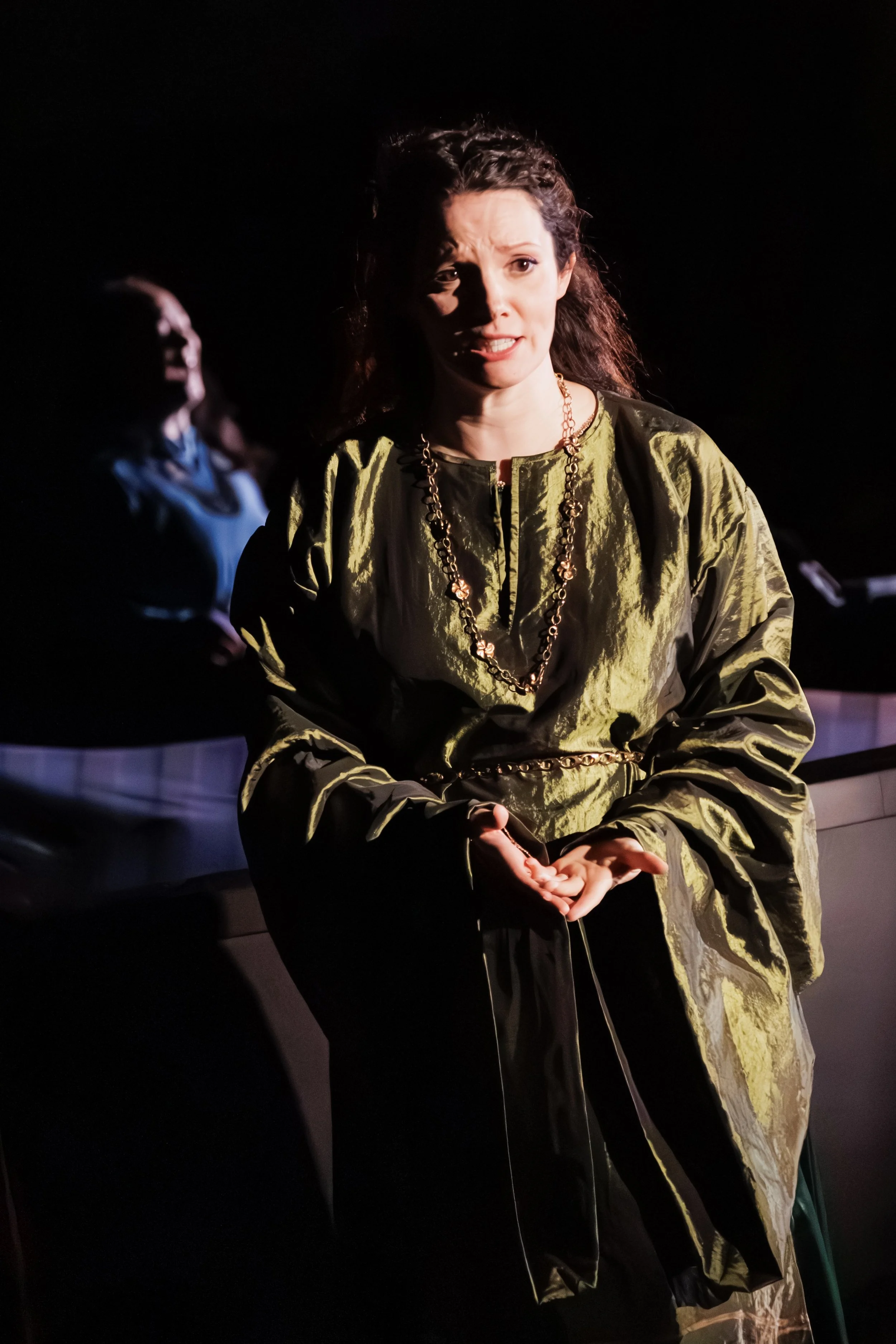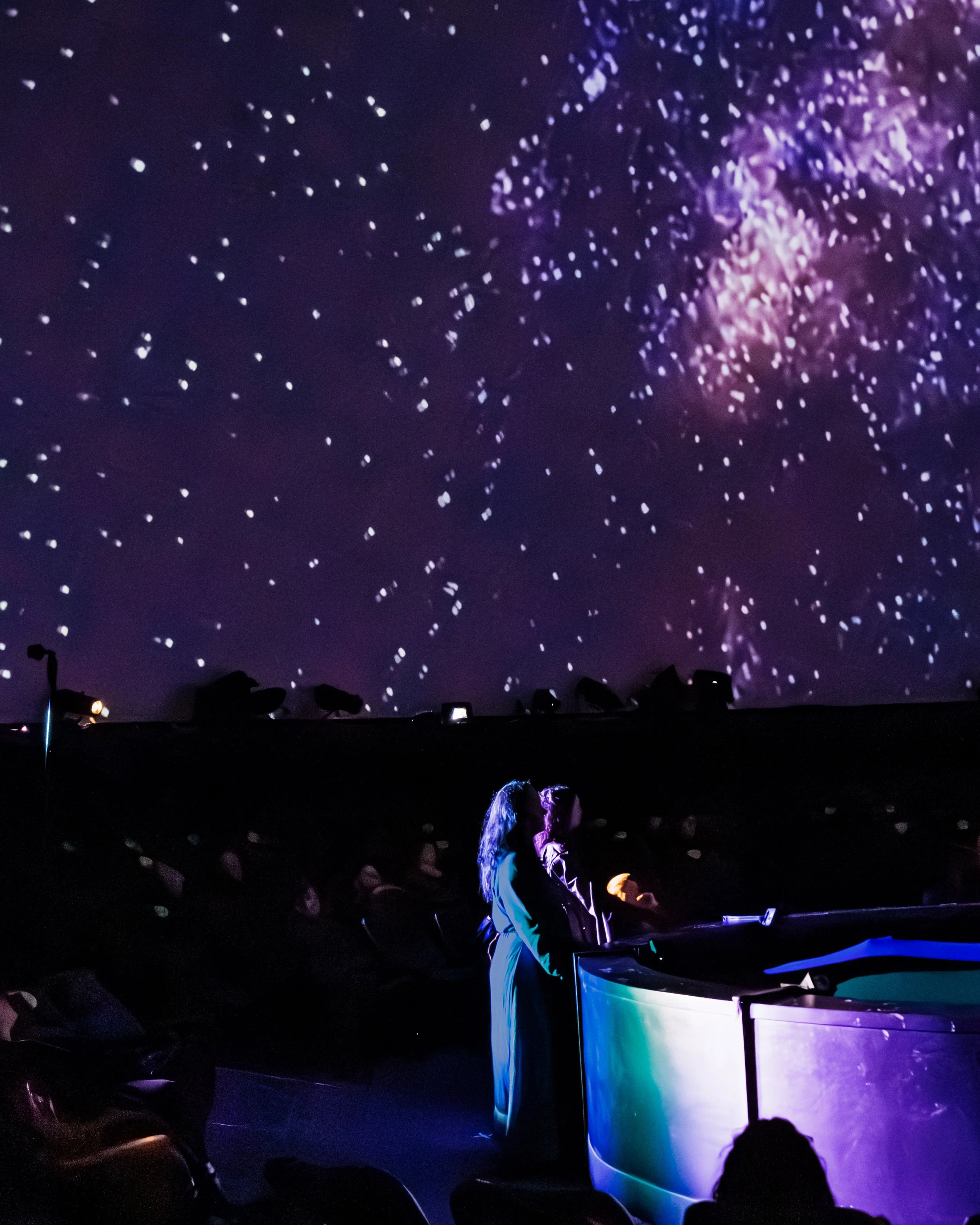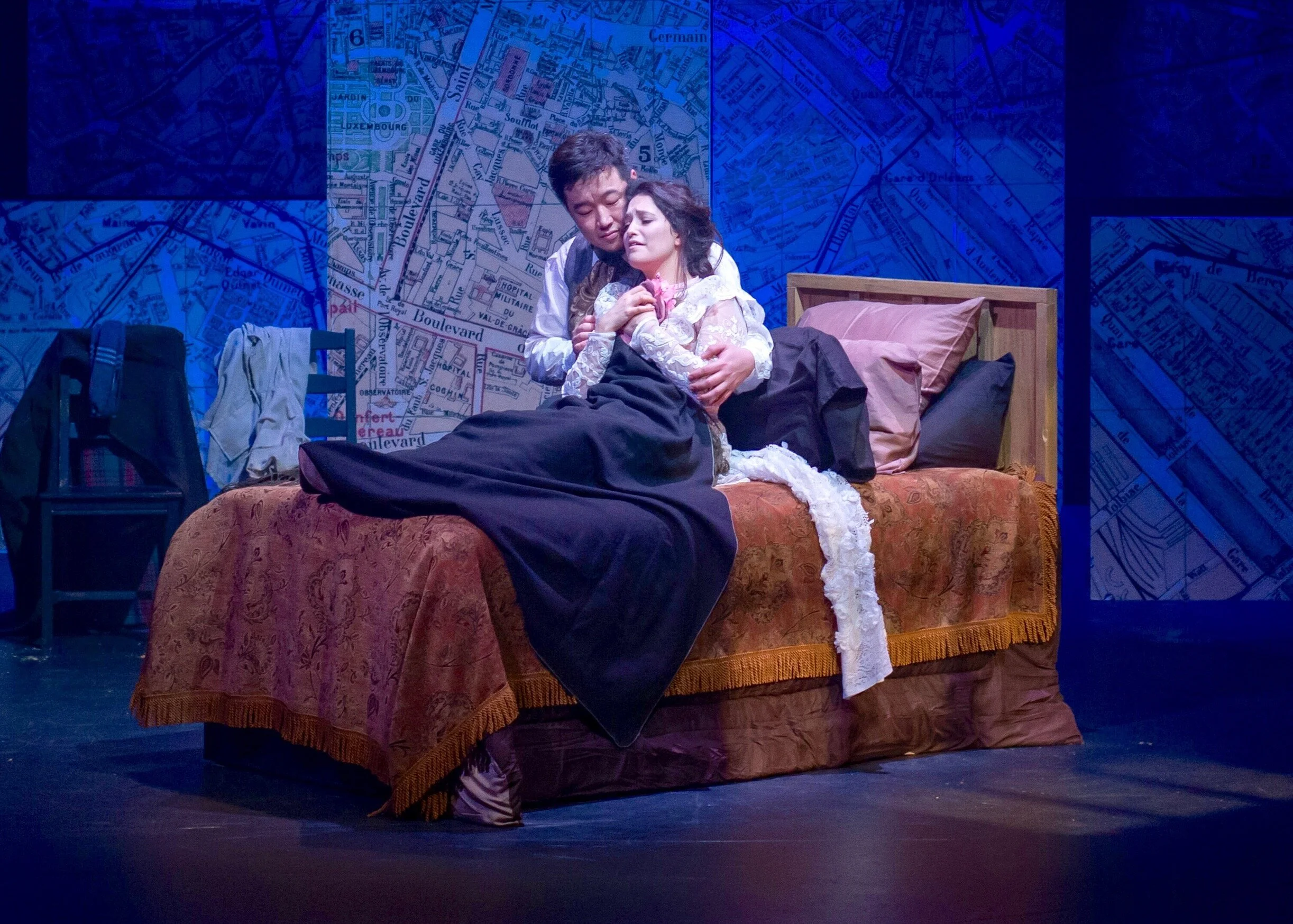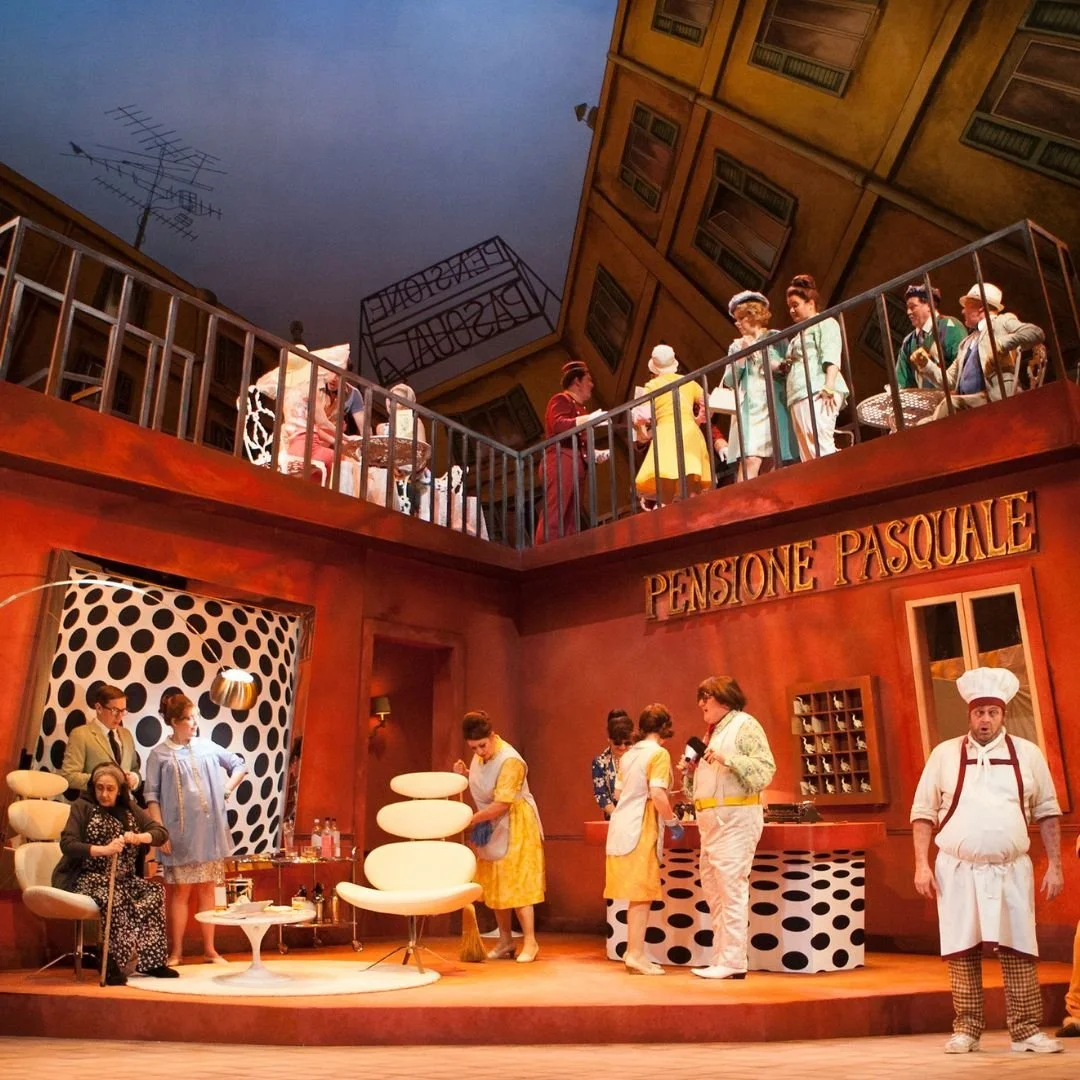Review: Sanctuary & Storm marries intergalactic planetarium projections with the strength of historic female figures
From Vancouver Opera and IndieFest, world premiere at the H.R. MacMillan Space Centre offers moments of passion and a matriarchal dynamic in an up-close, intimate environment
Dason Burton (left) and Marion Newman in Sanctuary & Storm. Photo by Pedro Augusto Meza
Vancouver Opera and re:Naissance Opera presented Sanctuary & Storm in the H.R. MacMillan Space Centre at Vanier Park to November 19
IN THE H.R. MACMILLAN Space Centre’s Planetarium Star Theatre, projections of indigo galaxies and nebulous skies ripple across a domed ceiling. Seated around the edges of the circular performance space, audience members lean back in their seats, gazing upwards in collective awe at the sights overhead while sneaking glances at the scenes unfolding below.
Normally ground zero for educational short films about space, the theatre has taken on a whole new purpose during re:Naissance Opera’s fourth annual IndieFest. Beneath the brightly coloured cosmos is the world premiere of Sanctuary & Storm, an immersive opera from composer Tawnie Olson and librettist Roberta Barker that’s coproduced with Vancouver Opera.
Sanctuary & Storm’s historic premise unites the lives of two strong 12th-century European women. Kwagiulth-Stó:lō First Nations mezzo-soprano Marion Newman is Hildegard of Bingen, and Ottawa-born soprano Mireille Asselin is Eleanor of Aquitaine, whose stories are intertwined by American baritone Dashon Burton as the Angel of History.
In a time warp back to the 1160s, Hildegard is a nun who founded her own monastery. When she’s approached by Eleanor for marriage advice in her relationship to King Henry II, she tells the younger woman to strive for peace. Eleanor, who values the sexual and reproductive joys of human evolution, finds qualms with this advice. Meanwhile, Hildegard stands firm in her opinion and devotion to spiritual bliss. The pair are soon approached by the Angel of History, who eases the women’s escalating argument with his presence. He creates space for intense reflection on passion, and the emptiness felt in its absence, allowing for common ground between Eleanor and Hildegard.
Under Sheree Spencer’s stage direction, Sanctuary & Storm is opera stripped down to its bare basics: song, music, and emotion. The three singers are accompanied by only an eight-member orchestra, which creates a wildly intimate environment between the audience and performers. Burton, Asselin, and Newman move freely around a circular walkway in the small theatre. They’re so close, in fact, that we’re given a warning before the show not to trip the performers by accident. They make frequent eye contact with audience members, and we can see the individual gems on Burton’s halo glimmer in the light.
Mireille Asselin in Sanctuary & Storm. Photo by Pedro Augusto Meza
Sanctuary & Storm. Photo by Pedro Augusto Meza
It’s no secret that the resonance of an opera singer’s voice is powerful enough to fill impressively vast spaces, from New York City’s 3,800-seat Metropolitan Opera to Moscow’s architecturally imposing Bolshoi Theatre. Here, there’s undoubtedly consideration to the environment the performers are in; their voice volumes are never overbearing or ear-piercing. Instead, their sound sits right in a pocket of pleasantry, suiting the theatre expertly.
The orchestra opens the show, situated in clear sight on a platform against the wall. Conductor Arianne Abela guides the musicians with refined power. An ominous tone is created right away with sharp, fast-paced piano notes, anxiety-inducing string, and the thunderous booms of a bass drum.
Outfitted in all white, Burton is commanding as the Angel of History, his voice rich with passion. As he holds up a flickering lantern, his shadow is cast twofold onto the domed ceiling above, giving him an all-powerful aura. “This is how one pictures the Angel of History: his face is turned towards the past,” Burton begins cryptically. An undulating portal opens up overhead, inside which images of historic texts and architecture fade by.
The end of Sanctuary & Storm is a callback to this moment—another celestial portal opens up, and this time, images of fire and ice flicker above, mixed with footage of war and climate protests. They may be archival photos and videos, but we’re under the impression that this is how the Angel of History sees the future.
As Hildegard, Newman is a matriarchal figure to Eleanor. She embodies the role with nobility in flowing azure robes, offering expressions of tender concern. “My daughter, your mind is like a wall that is battered by a storm,” she declares solemnly to the queen. Asselin, who’s spent five seasons performing with the Metropolitan Opera, sings the part of Eleanor with exquisite clarity. As the daughter figure, she has a feistiness that’s characterized by brisk steps, sharp glances, and a bit of sass (think smirks, raised eyebrows, and crossed arms). Though there are not many moments of interaction between all three moguls, Burton brings calm to heated exchanges between Asselin and Newman when they are together.
Throughout the show, breathtaking projection designs by Mily Mumford drift overhead. Webs of constellations twinkling up above give way as the sky turns tangerine, bursting with light. Elsewhere, we are transported to the ground when a forest scene appears. Clouds roll through in fast-motion while flocks of crows fly by. Later on, a full moon starts out small before drawing incredibly close, encompassing the ceiling. Each moment offers a new wow factor to appreciate.
Emotionally profound and visually stunning, Sanctuary & Storm is an interstellar getaway, transporting audiences through a universe of push-and-pull passion. It’s safe to say that when we’re brought back down to Earth at the end of the show, we’re left wanting more.
Sanctuary & Storm. Photo by Pedro Augusto Meza

















